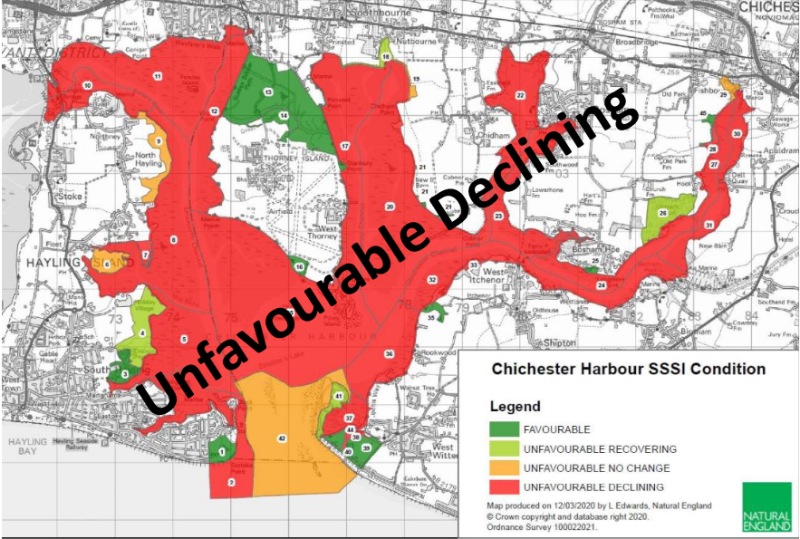Today nature is declining globally at rates unprecedented in millions of years. The 2020 Global Living Planet Index (LPI) shows an average 68% fall in monitored populations of mammals, birds, amphibians, reptiles and fish between 1970 and 2016.
Around one million animal and plant species – almost a quarter of the world’s total – are believed to be threatened with extinction.
In the UK, the State of Nature Report 2019 confirms that “the abundance and distribution of the UK’s species has, on average, declined since 1970…..there has been no let-up in the net loss of nature”.
Sadly, protected landscapes such as National Parks and Areas of Outstanding Natural Beauty (AONBs) have not been excluded from this decline, and coastal habitats are no exception with 85% of saltmarsh lost, 100% of seagrass lost in over half English waters and 95% of native oyster populations lost.

The State of Nature in Chichester Harbour
In February 2021, Natural England published the Condition Review of Chichester Harbour sites: intertidal, subtidal and bird features (NERR090). This report was based on a study conducted to assess whether the Harbour’s special habitats and species (known as notified features) were flourishing – or as Natural England describe features of designated sites: in favourable condition.
The report reviewed the historic trends in populations and condition of notified features, discussed whether the existing conservation actions were appropriate, and identified what changes are required to improve the site and its features.
The report showed that Chichester Harbour has seen a dramatic loss in saltmarsh habitat: 58.8% of the historic extent of the saltmarsh in 1946 has been lost, with 46.5% of the saltmarsh being lost since designation as a Site of Scientific Interest (SSSI) in 1970. It estimates that on average 2.54 hectares of saltmarsh (the equivalent of more than 3 football pitches in area) is still being lost every year across Chichester Harbour.

The report estimates that seagrass beds only cover a relatively small area of 136ha, however if conditions are improved, the potential for seagrass beds is far greater.
Furthermore, Native Oyster (Ostrea edulis) populations which were once abundant in the Harbour and formed a vital local industry in the late 1800s to early 1900, have now declined to such low levels that they can no longer be harvested.
This loss of habitat is also impacting dramatically on some wetland bird populations, through loss of high tide roosting sites, nesting sites and changes to food supply and feeding conditions. This is highlighted in particular by the decline in nesting tern populations but affects other important bird species too.
Without urgent action, the rate and scale of this deterioration within the Harbour is only set to continue at an accelerating pace. Consequently, Natural England’s Condition Review of Chichester Harbour sites downgraded the SSSI. Overall, the main intertidal habitats and bird features were assessed as unfavourable declining condition largely due to the continued loss of saltmarsh, the poor quality of saltmarsh and mudflat habitat, and the continued decline of several bird species (wintering and nesting).